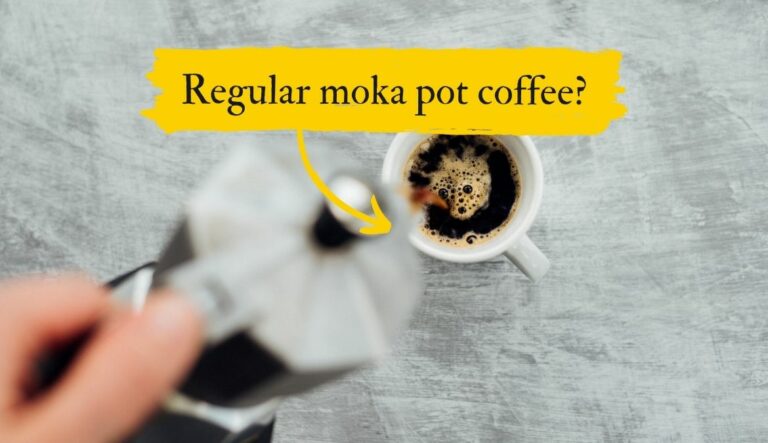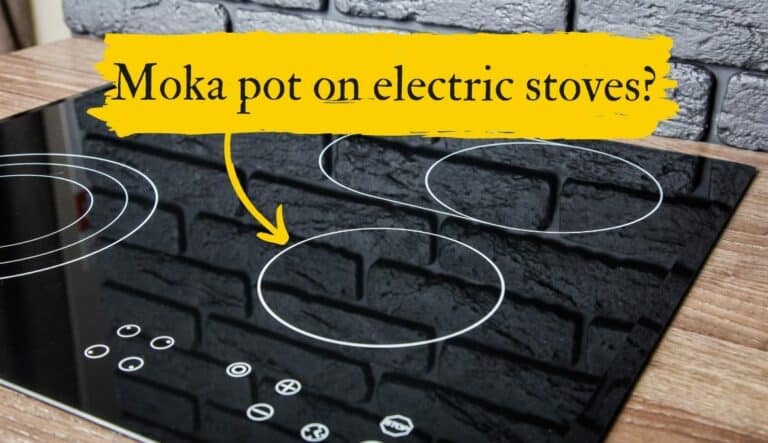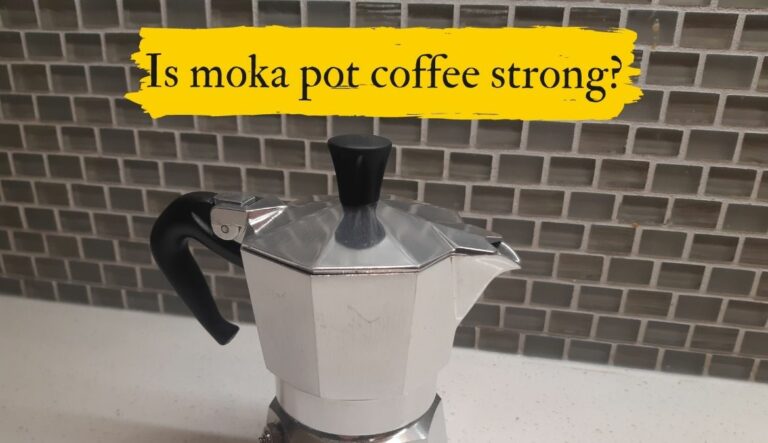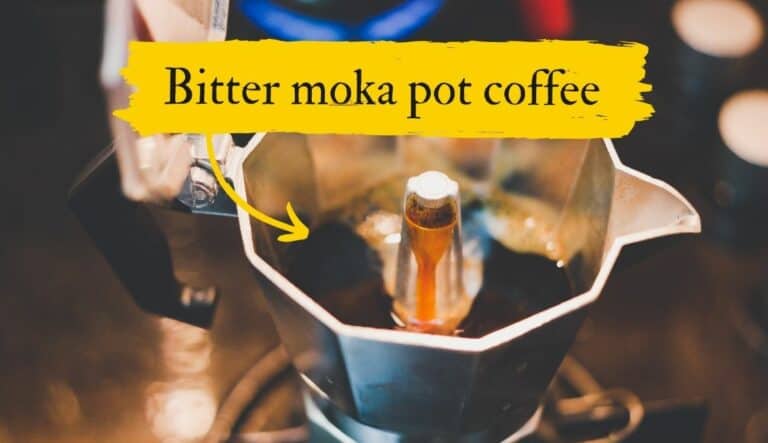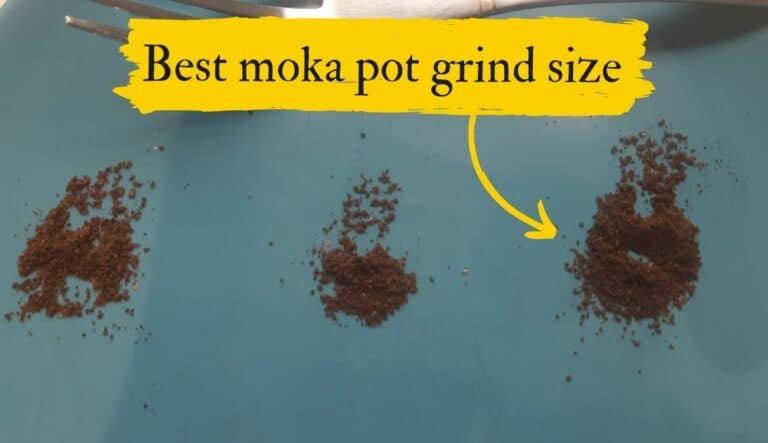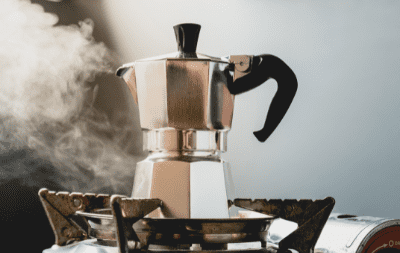
The best things in life often require a little (or a lot!) of extra effort, and coffee is no exception. Using a Moka pot to get your caffeine fix undoubtedly gives you a richer brew, but it can be somewhat frustrating at times. Especially if you encounter problems and you don’t know what is causing them. One particularly common Moka pot problem is sputtering.
So, why is my Moka pot sputtering? Moka pot sputtering is often caused by excessive internal pressure due to too much heat. It can also be the result of a poor seal between the upper and lower chambers. This might be because it was not screwed together tightly enough, or perhaps the rubber seal ring needs replacing.
Knowing the cause of your sputtering might not be much help if you’re not familiar with the mechanics of a Moka pot. So let’s explore why these issues cause sputtering and what you can do to fix them.
Why pressure causes Moka pot sputtering
The key factor in this dilemma is pressure. In order for your hot water to be forced up and out of the lower chamber, and then through the coffee grounds and into the upper chamber, pressure needs to build up and force the water out. In order for an adequate amount of pressure to build up, your Moka pot needs to be sealed.
Having an imperfect seal between the two main chambers of your Moka pot creates openings where the pressure can be released. Granted, it is unlikely to be enough of a leak to prevent your Moka pot from doing its job, but it may cause sputtering to occur and take longer to brew.
Not to mention, it can be very annoying if you are in earshot while it’s sputtering away.
This lack of pressure may also prevent the entire water chamber from brewing, leaving you with a partial cup of coffee.
An improper seal can cause sputtering
Excessive pressure is essentially the same problem as having an improper seal; you just get there from a different direction. Your Moka pot is designed to work with pressure, but not a lot of pressure. After all, it is just a small tool for making a beverage in your kitchen, or perhaps over a campfire; it doesn’t need to be designed to work with extremely high pressures. So how do you wind up with too much pressure?
Assuming you keep your Moka pot nice and clean (if you don’t, check that the spouts are not blocked), the most likely cause of sputtering is too much heat. The water may have a clear path to the upper chamber, but it still has to travel through two small orifices and the central chamber, which is packed with coffee grounds.
If you heat your Moka pot too high, the pressure will increase faster than the water can get out of the way, and so it will escape any other ways it can, which includes the light seal that was designed for lower pressures.
Why Moka pot sputtering is common
There are three chambers to a Moka pot, the lowest of these chambers is where you put your water. The middle chamber is where the coffee grounds go, and the top chamber is where your brewed coffee waits until you’re ready to pour. Of course, there are other components in there, but the important thing to note is the two “spouts,” the downward-facing spout in the lower water chamber and the upward-facing spout in the upper coffee chamber.
The process relies on the fact that hot air expands a lot. When you heat the Moka pot, it heats the water, of course, but it also heats the air inside the chamber, which expands. As water is heavier than air, the air rests at the top of the chamber and has nowhere to go as it expands, so the pressure in the chamber increases.
The water, on the other hand, does have somewhere to go; up through the spout, whose opening is near the bottom of the chamber. So the expanding hot air pushes against the water, which is then driven up through the spout and into the chamber with the coffee grounds.
From there, the hot water mixes with the coffee grounds, and extraction occurs, transferring that caffeinated goodness into the water. Eventually, though, the pressure in this chamber starts to force the water up through the next spout and into the top chamber.
The mouth of the spout is near the top of the chamber, so water falls into the upper chamber but can’t drain back out. When you start to hear a gurgling sound from inside your Moka pot, the last of the water is being pushed up through the upper spout by the expanding hot air, and your coffee is ready.
How to Prevent my Moka Pot From Sputtering
Now that you have a good understanding of what is going on inside your Moka pot let’s talk about how to put an end to that annoying sputtering problem.
Keep Your Moka Pot Clean
The first thing to do, assuming you don’t already do it, is to make sure your Moka pot is clean. If either of the spouts inside the pot becomes wholly or partially blocked, it will prevent the water from traveling from the bottom of the pot to the top, thus increasing the pressure that builds up.
It is much easier to stay on top of this by cleaning your Moka pot regularly; that way, you won’t find yourself struggling to clear out the build-up of multiple brews worth of coffee grounds from your pot. In truth, these spouts shouldn’t get blocked, but it’s worth making sure before assuming there’s something more serious wrong.
Keep the Sealing Surfaces Free of Coffee
The next thing to look at is the surfaces where the parts of your Moka pot press together when you screw it together. If you are getting bits of coffee on those surfaces, they can be just enough to stop the Moka pot from sealing properly. Water does not need much of an opening at all to seep through, especially when it is under pressure.
Lower the Heat
No matter how clean and well-sealed your Moka pot is, it is possible to generate too much pressure by heating it too much. Fortunately, this one is an easy fix-simply turn the heat down.
If turning the heat down adds too much time to your brewing process, you might consider having your pot on full heat until the water inside begins to boil and then dialing the heat back a bit, just far enough that the sputtering stops.
Other Things to Remember
Much of this should be intuitive once you understand how the Moka pot works, but there are some other things to be aware of if you want to get that perfect pot of coffee every time.
Don’t Overfill Your Pot
We mentioned above that the heated and expanding air in your pot is what pushes the water up through the coffee grounds and, ultimately, into the upper chamber, ready for you to pour. The fact that it is the air that does the pushing is essential, as it means you need some air in the chamber to expand in the first place. Of course, the heated water will undergo some evaporation, adding to the air in the lower chamber, but you will get a much more efficient brew if you ensure there is some air in the chamber, to begin with. Many Moka pots have a fill line for this very reason.
Don’t Overstuff Your Coffee
Some people like to heap their coffee grounds into the basket, usually with the idea being that the more coffee you have in there, the more flavor you will get out of it. While that may be true in theory, it’s worth remembering that there is only so much space inside the middle chamber, and the water has to pass through that space on its way to the upper chamber and, ultimately, your mug.
You probably won’t be able to pack in enough coffee that you can’t seal up your Moka pot as the coffee grounds will pack down quite easily, but the more densely packed your coffee grounds are, the less space there is in between the coffee grains for the water to pass through, thus increasing the pressure that needs to be generated to get the water into that top chamber. This can also contribute to that sputtering problem that brought you here in the first place.
Final Thought
Another thing to consider in regards to the coffee density is the coarseness of your coffee grounds. The finer the coffee ground, the less space there will be between the grains for the water to pass through. If none of the above tips have been able to solve your sputtering problem, try coarser coffee grounds.

